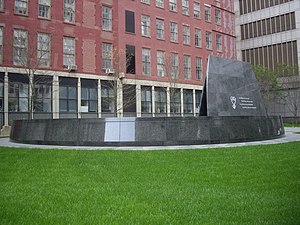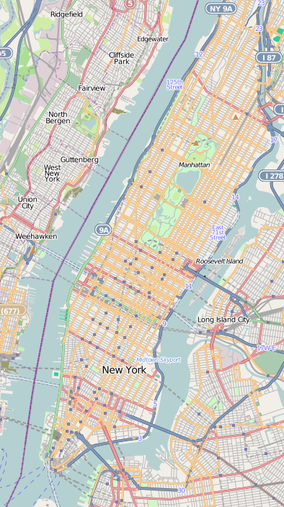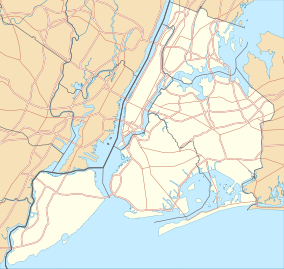
Back Monument nacional Cementeri Africà Catalan African Burial Ground National Monument CEB African Burial Ground German Monumento nacional Cementerio Africano Spanish African Burial Ground Finnish African Burial Ground National Monument French アフリカ人墓地ナショナル・モニュメント Japanese African Burial Ground National Monument Dutch African Burial Ground National Monument Polish
| African Burial Ground National Monument | |
|---|---|
 The African Burial Ground National Monument in October 2007 | |
| Location | 290 Broadway, New York City, NY 10007 |
| Coordinates | 40°42′52″N 74°00′16″W / 40.71444°N 74.00444°W |
| Area | 0.35 acres (0.14 ha)[1] |
| Created | February 27, 2006 |
| Visitors | 108,585 (in 2011)[2] |
| Governing body | National Park Service |
| Website | African Burial Ground National Monument |
| Designated | April 19, 1993 |
| Reference no. | 93001597[3] |
| Architects | Rodney Léon and Nicole Hollant Denis |
| Designated | February 27, 2006 |
African Burial Ground National Monument is a monument at Duane Street and African Burial Ground Way (Elk Street) in the Civic Center section of Lower Manhattan, New York City. Its main building is the Ted Weiss Federal Building at 290 Broadway.[4] The site contains the remains of more than 419 Africans buried during the late 17th and 18th centuries in a portion of what was the largest colonial-era cemetery for people of African descent, some free, most enslaved.[5] Historians estimate there may have been as many as 10,000[6]–20,000 burials in what was called the Negroes Burial Ground in the 18th century. The five to six acre site's excavation and study was called "the most important historic urban archaeological project in the United States."[7] The Burial Ground site is New York's earliest known African-American cemetery; studies show an estimated 15,000 African American people were buried here.[8]
The discovery highlighted the forgotten history of enslaved Africans in colonial and federal New York City, who were integral to its development. By the American Revolutionary War, they constituted nearly a quarter of the population in the city. New York had the second-largest number of enslaved Africans in the nation after Charleston, South Carolina. Scholars and African-American civic activists joined to publicize the importance of the site and lobby for its preservation. The site was designated a National Historic Landmark in 1993 and a national monument in 2006 by President George W. Bush.
In 2003 Congress appropriated funds for a memorial at the site and directed redesign of the federal courthouse to allow for this. A design competition attracted more than 60 proposals. The memorial was dedicated in 2007 to commemorate the role of Africans and African Americans in colonial and federal New York City, and in United States history. Several pieces of public art were also commissioned for the site. A visitor center opened in 2010 to provide interpretation of the site and African-American history in New York.
- ^ "Listing of acreage – December 31, 2011" (XLSX). Land Resource Division, National Park Service. Retrieved March 18, 2012. (National Park Service Acreage Reports)
- ^ "NPS Annual Recreation Visits Report". National Park Service. Retrieved March 18, 2012.
- ^ "National Register Information System". National Register of Historic Places. National Park Service. July 9, 2010.
- ^ "African Burial Ground National Park Service". Archived from the original on October 6, 2012. Retrieved November 18, 2013.
- ^ "African Burial Ground National Monument". National Park Service. Archived from the original on October 6, 2012. Retrieved November 18, 2013.
- ^ "Gale - Product Login". Archived from the original on August 20, 2022. Retrieved November 20, 2016.
- ^ Cite error: The named reference
ABGwas invoked but never defined (see the help page). - ^ "African burial Museum". Archived from the original on October 6, 2012. Retrieved November 18, 2013.



